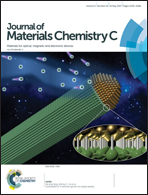Electric-field-induced widely tunable direct and indirect band gaps in hBN/MoS2 van der Waals heterostructures†
Abstract
First-principles calculations demonstrate that widely tunable direct and indirect band gaps can both be obtained in hBN/MoS2 vertical heterostructures, under a finite vertical electric field (E-field). In hBN/MoS2 bi- and multi-heterostructures, the interactions between the two individuals produce a very special γ-band. Then, an enhancing forward E-field shifts this γ-band down and makes its lowest point become the conduction band minimum (CBM) of the hBN/MoS2 bilayer at 0.47 V Å−1, leading to a continuously tunable direct band gap. In contrast, an enhancing backward E-field shifts the valence band maximum (VBM) of the hBN up and makes it become the VBM of the hBN/MoS2 bilayer at −0.07 V Å−1, resulting in a highly tunable indirect band gap. Moreover, the magnitude of the two critical E-fields is obviously reduced when increasing the layer number of hBN flakes, offering multiple choices to devise band-gap tunable MoS2-based devices under only a weak E-field, which may be a significant breakthrough in MoS2-based field-effect transistors and photodetectors.



 Please wait while we load your content...
Please wait while we load your content...